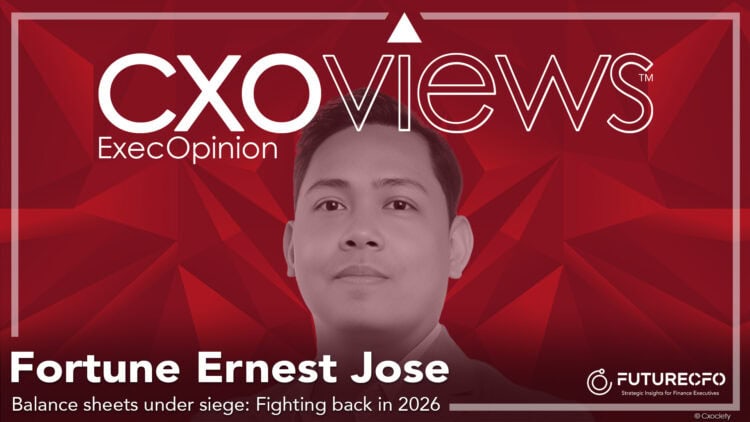As we step into 2026, Asia’s finance leaders find themselves at a critical inflexion point. The rhythm of global commerce continues to shift, driven by geopolitical turbulence, climate volatility, and rapid technological change.
In this evolving landscape, the balance sheet is no longer just an accounting record; it has become a battleground where resilience, agility, and foresight are tested daily. At the heart of this transformation stands the modern CFO, expected not only to safeguard financial health but to lead enterprise-wide adaptation.
Fortune Ernest Jose, vice president for finance at Enderun Colleges in the Philippines, offers timely wisdom for finance executives navigating these uncharted waters. His insights illustrate real-world issues finance leaders face as they lead their teams and organisations through the challenges of a volatile and unpredictable marketplace.
Build resilient buffers
Jose stresses the need for strategic balance:

“A strategic balance has to be achieved in building resilient financial buffers and sustaining investment in growth in an environment of continuing supply chain volatility.” Fortune Ernest Jose
He advocates for a dedicated reserve fund—perhaps a fixed percentage of revenue or profit—acting as a shock absorber during disruptions. This mirrors practices seen in leading tech firms, which maintain contingency reserves without sacrificing innovation.
Flexible budgeting complements these buffers. By prioritising critical growth initiatives while retaining the ability to pivot, CFOs can protect long-term vision amid short-term chaos. Real-time monitoring and scenario planning further enhance agility, enabling swift resource reallocation when risks emerge.
For CFOs in typhoon-prone or geopolitically exposed markets—from Manila to Jakarta—this approach isn’t optional. It’s survival.
“With such flexibility of planning, real-time visibility, strategic investments, and prudent reserve management, organisations can maintain their pace of growth without jeopardising their financial strength over ambiguous conditions,” adds Jose.
Hedge rising costs
Escalating freight, raw material, and energy prices remain top of mind. Jose recommends a multi-pronged strategy, including long-term supplier contracts to lock in pricing, financial hedging tools such as futures and forwards, and strategic buffer stocks.
“Amazon usually did and does with their stocks,” he notes, highlighting how inventory discipline prevents production slowdowns during market spikes.
Energy efficiency investments also pay dividends. Referencing Tesla’s energy-optimised factories, Jose underscores how reducing consumption lowers operational costs and insulates margins. Diversifying logistics providers and sourcing regions—such as apparel brands sourcing fabric from multiple countries—reduces dependency and strengthens negotiating power.
“These strategies can assist the management of organisations to control the mounting expenses, more effectively and protect the profitability of the firms in the unpredictable economic scenario,” suggests Jose.
According to McKinsey & Company, companies that actively hedge energy and commodity risks see up to 15% higher EBITDA stability during price shocks.
Test contract agility
Are supplier contracts truly agile? Jose urges a rigorous review: “Before evaluating the financial agility of your current supplier contracts… You will need to review flexibility and terms thereof.” Force majeure clauses, cost pass-through mechanisms, and renegotiation rights are essential, especially in disaster-prone regions like the Philippines.
He cites manufacturers in Luzon whose contracts allow adjustments when fuel surges increase transport costs. Similarly, suppliers in Cebu or Mindanao may include clauses for delays due to infrastructure damage—a necessity in a country regularly hit by typhoons.
Just-in-time models, which rely on single-source suppliers, are increasingly risky. The solution? Build redundancy through alternative routes and emergency inventories.
“These factors assist companies in developing more flexible and robust supply chains against the risks of the country.” Fortune Ernest Jose
As Gartner notes, “By 2026, 70% of Asian supply chains will have built regional redundancy to counter climate and geopolitical risks.”
Forecast cash flow
Predicting cash flow amid unpredictable lead times and input prices demands a new toolkit. Jose champions dynamic forecasting models that are updated weekly using real-time data, ranging from fuel indices to customs clearance times.
“A manufacturing company may change their forecasts on a weekly basis using current fuel prices,” he explains.
Pessimistic assumptions—such as a 15% surge in shipping costs during the monsoon season—help stress-test projections. Real-time monitoring via GPS trackers and commodity price dashboards enables timely course corrections. Buffer funds, he adds, act as insurance against unforeseen expenses:
“Making pessimistic assumptions about the cost of inputs and time lead to costs, such as a likelihood of a 15% shipping cost surge under inclement weather, can create robust cash flow simulations in the light of uncertainty or sudden disturbances.” Fortune Ernest Jose
This proactive stance aligns with PwC’s 2025 Finance Trends Report, which found that CFOs using AI-enhanced forecasting tools report 30% greater accuracy in cash flow predictions.
Reshore or nearshore?
The reshoring debate is no longer theoretical; it has become a reality. Jose frames it as a total cost of ownership decision: “Reshoring or nearshoring might result in increased labour cost… but it is best to look into the overall cost of ownership.”
Lower logistics expenses, reduced tariffs, improved responsiveness, and better regulatory compliance often outweigh the higher costs associated with domestic wages.
For pharmaceutical firms, local production ensures adherence to stringent standards. For tech companies, nearshoring to Vietnam or Thailand cuts lead times and strengthens customer satisfaction.
However, the balance sheet impact is real—new facilities and equipment increase fixed assets and depreciation, while transition costs strain cash flow.
Jose warns: “Conduct a close cost-benefit analysis, having factored in the initial transition costs and the cost of sustaining operations.”
With the current US economic policy favouring local production, he comments:
“Reshoring has the potential of affecting the balance sheet because the capital services of new premises and new equipment add to the value of assets and depreciation, whereas the high cost of operations can affect the cash flow and profitability ratios.”
Leverage digital tools
Accenture reports that early adopters of AI in supply chain planning have reduced stockouts by 40% and improved inventory turnover by 25%.
AI and predictive analytics are no longer futuristic—they are foundational. Jose sees them as critical for anticipating disruptions: “AI-based models to study the previous data and observe patterns that indicate possible disturbances.”
Machine learning improves demand forecasting, while IoT sensors offer real-time visibility into inventory and shipments.
Supplier risk assessment tools powered by AI can identify financially unstable partners before they fail. Automated alert systems enable rapid responses, allowing for the instant switching to subcontractors or adjusting production schedules.
Correctly applied and tested, these technologies can increase an organisation’s overarching supply chain resilience, says Jose.
Prioritise ESG
Sustainable sourcing may cost more, but Jose insists ESG is strategic: “Integration of ESG factors can go a long way in enhancing the reputation of a company.”
Ethical suppliers reduce reputational risks and regulatory fines, while fostering innovation. Unilever’s sustainable supply chain, for example, has driven product innovation and brand loyalty.
Though initial costs are higher, long-term value prevails.
“ESG-compatible suppliers tend to deliver greater value in the long run,” Jose says. CFOs must strike a balance between cost and resilience, selecting partners who demonstrate transparency and share their values.
Maintain profitability
Margins under pressure? Jose recommends cost optimisation, product differentiation, and honest investor communication. “Apple preserves large margins by marketing innovative and high-end products,” he notes.
Gradual price adjustments, supply chain diversification, and targeting high-margin segments help sustain profitability.
Crucially, transparency builds trust. “Honest communication to investors regarding problems in the supply chain… assists in maximising trust and confidence,” Jose says—echoing how pharma firms disclose risks proactively.
“In the long run, the higher costs associated with sourcing can be compensated by increasing brand loyalty through the construction of a resilient, responsible supply chain that leads to the creation of competitive advantages,” asserts Jose.
Optimise working capital
Working capital must serve dual goals: short-term stability and long-term transformation. Jose highlights Apple’s credit term mastery and Toyota’s lean inventory as models to follow. Real-time analytics and predictive models help align cash flow with strategic goals.
“Balancing between saving cash to make strategic investments and ensuring liquidity levels… is a judgment call,” he observes—a challenge familiar to retail chains adjusting inventory in volatile markets.
“All these strategies combine to ensure that organisations survive external pressures and maintain profitability and confidence with stakeholders,” suggests Jose.
Drive cross-functional alignment
Finally, CFOs must lead collaboration. Jose champions joint KPIs, shared dashboards, and scenario planning exercises. “Financial executives may have a leading role in promoting cross-functional collaboration,” he says, citing Procter & Gamble’s integrated risk forums.
A risk-aware culture, supported by aligned incentives, ensures that procurement, operations, and sales move in lockstep, critical in times of crisis.
“Lastly, to facilitate flexible incentive and reward structures, team priorities would be aligned to be more proactive in mitigating risks and efficiency gains, a strategy that is needed to manage the more turbulent periods ahead,” concludes Jose.



